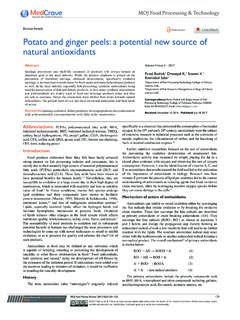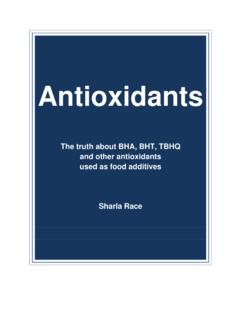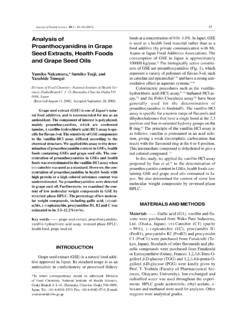Transcription of A CONCISE UPDATE OF IMPORTANT ISSUES …
1 Our ability to see is made possible in part bythe fact that our eyes allow light to pass throughwith relative ease. This makes the eye the mostsusceptible organ to oxidative damage caused bylight, toxins (smoke), atmospheric oxygen, andabrasion. In the United States, age-relatedmacular degeneration is the leading cause ofblindness for persons over 60 years of are still the leading cause of visualimpairments in the , resulting in the highestportion of the Medicare budget, consuming $ annually. Both of these diseases havebeen shown to be a direct result of accumulatedoxidative damage. Unfortunately, except for thereplacement of opaque lenses, there is notreatment for either of these conditions. We hopeto show here that through diet and the generoususe of certain antioxidants you can help yourpatients greatly reduce and possibly reverse theoxidative damage that leads to Age-relatedMacular degeneration (ARMD) and cataracts.
2 Macular DegenerationThe macula is the central portion of the retinaresponsible for acute and detailed vision. In the centralportion of the macula, called the fovea centralis, theinnermost layers of the retina are displaced to one sideallowing light to pass unimpeded to this portion of theretina. This allows for increased visual acuity, but alsoincreases the possibility of light induced damage to thisarea of the retina. Macular degeneration is characterized bya gradual loss in central acuity and the presence of drusen(bumps) in the macula. This is commonly called the dry form, and constitutes about 90% of the cases of maculardegeneration. The other 10%, called wet form, ischaracterized by rapid loss of central acuity,neovascularization, and vessel leakage. Wet ARMD istreatable with laser therapy, while dry ARMD isconsidered untreatable.
3 As ultraviolet and blue light pass through the retina tothe photoreceptors (rods and cones) and the pigmentedepithelial (PE) cells, reactive oxygen species are conversion of this light energy into a nerve impulse bythe photoreceptors generates more free radicals. Typically,these free radicals are reactive oxygen species such ashydrogen peroxide, superoxide and hydroxyl reactive molecules are quick to grab electrons fromsurrounding molecules to add to their unpaired is fine when the surrounding molecules are one of themany antioxidants in the eye, which are able to quenchfree radicals without themselves becoming free radicals. Ifinstead the electron is taken from one of the lipids in thephotoreceptor membranes (stacks of memranous discsthat are rich in polyunsaturated fatty acids), lipidperoxidation cascades through the photoreceptor outersegments.
4 These may be subsequently quenched byvitamin E or other lipid soluble antioxidants, or they willcontinue to damage the integrity and fluidity of thesemembranes. When photoreceptor membranes become damaged,the outer portion is sloughed off into the PE cells, and newdiscs are regenerated. PE cells are equipped to phagocytize,digest and recycle these compounds under normalconditions. However, when these molecules have beenmodified by oxidation of their unsaturated bonds, they arenot easily digested by the lysosomal enzymes. The result isa build-up of undigested molecules in the PE cells calledlipofuscin granules. When a sufficient amount oflipofuscin has accumulated, the PE cells deposit thesegranules resulting in a bump between the pigmentedepithelial cells and choriod. This bump is called drusen(German: bumps ).
5 This physical and metabolic1999 Volume 2, By: Thomas G. Guilliams , ANTIOXIDANTS AS INCURABLE AS WE ONCE CONCISE UPDATE OF IMPORTANT ISSUES CONCERNING NATURAL HEALTH INGREDIENTS2separation of the PE cells and the photoreceptors fromtheir blood supply in the choroid results in damage to thephotoreceptors and eventually macular degeneration (SeeFigure 1 and 2). A case-control study was performed to determine therisk factors associated with ARMD. They found these riskfactors, reported with their odd ratio: arterial hypertension(OR= ), coronary disease (OR= ), hyperopia(OR= ), and lens opacities or previous cataract surgery(OR= ) (3). Those individuals who are aphakic (havehad their lens removed) were times more likely to haveARMD (4).CataractA cataract is a lens that limits the transmission of lightto the retina because it has become opaque.
6 The incidenceof cataracts in persons 65-75 years range from 21% inwhite men to nearly 40% in black women (2). Overall,this effects nearly 10 million Americans, resulting in600,000 lens replacement surgeries per year in the UnitedStates. A number of factors contribute to the developmentof cataracts, these include congenital defects, trauma, age,and metabolic or toxic agents. By far the two mostcommon factors would be age (often called senilecataracts) and disorders of carbohydrate metabolism(especially diabetes). Proteins in the lens are unusually long lived and arethus subject to extensive and accumulated oxidativedamage. The damaged proteins accumulate, aggregate,and precipitate; causing the lens to loose its critical importance is the decrease in the Na+/K+ATPase,resulting in the inability to maintain steady concentrationsof Na+, K+, and Ca++within the lens.
7 The decreased activityof this enzyme is thought to be associated with oxidativedamage to the sulfhydryl portions of the molecule, usuallyprotected by the interaction of several antioxidants,especially glutathione (GSH), ascorbate, superoxidedismutase (SOD), and catalase. Like the processes leadingto ARMD, senile cataracts are the result of years of damageand accumulated oxidation. Several reviews are availablethat discuss the relationship between cataracts andoxidative damage (5,6,7,8). Diabetes and the EyeThe deficiency of proper glucose metabolism in thediabetic patient leads to two ocular conditions: diabeticretinopathies, and diabetic cataracts. Diabetes is theleading cause of acquired blindness in the ,retinopathies account for most of these. Diabeticretinopathies are associated with microaneurisms behindthe retina causing edema and are prone to leakage (calledbackground or non-proliferative type) or by new bloodvessel formation (neovascularization) on the surface of theretina (called proliferative type).
8 Laser photocoagulation isoften used to destroy and delay neovascularization, which,if untreated, can result in the loss of vision for nearly 10%of IDDM cataracts, and to some extent retinopathies,seem to have a direct relationship with the enzyme aldosereductase (9). Hyperglycemia stimulates the conversion ofglucose to sorbitol in the lens via aldose reductase. Sorbitolcannot be transported through the lens membrane and istherefore accumulated in the lens tissue. This creates ahypertonic condition, causing water to flow into the lenstissue to maintain osmotic equilibrium. Membranepermeability is thus altered, resulting in the loss of severalimportant molecules including glutathione, magnesium,and potassium. The use of aldose reductase inhibitors toreduce the sorbitol concentration within the eye hasshown positive results for diabetic cataracts (10) as well asretinopathies (11).
9 Antioxidants- The key to prevention. As we have outlined already, the cumulative effects ofoxidative damage are the primary cause of maculardegeneration and cataract formation. It would seem quitelogical then, that antioxidants would play a direct role inpreventing and possibly reversing the formation of theseconditions. This hypothesis has been confirmed by severalrecent scientific studies and is now becoming more widelyunderstood and accepted by those who have patients withan increased risk for such conditions (1, 12).AscorbateAscorbate accumulates in ocular tissues several timeshigher than in plasma, and furthermore is at a higherconcentrations than other water soluble antioxidants inthe ocular tissue. Ascorbate levels, as we shall see, are criticalto the overall antioxidant protection of the eye. It has beenshown that, in cells isolated from the retinal pigmentedepithelium, the amount of radiation delivered by a visiblelaser was directly proportional to the amount of ascorbicacid oxidized to dehydro-L-ascorbic acid (DHA) (13).
10 Thisimplies that ascorbate is one of the first antioxidants usedto quench light-induced free radicals. This would beexpected since ascorbic acid is very effective at quenchinghydrogen peroxide radicals, one of the major secondaryfree radicals formed during the quenching of superoxideby SOD (superoxide is formed directly from light energy).Ascorbate is also able to protect alpha tocopherol (VitaminE) from oxidation within the rod outer segments (14), afunction that is enhanced by both glutathione and lipoic(continued from page 1)Volume 2, LightUV - radiationEnergy Absorbing Molecules(Visual Pigments)Molecular OxygenQuenched CompoundsLipid molecules from membraneDamaged MoleculesPhagocytized by PE cells (requires zinc)Non-digestable MoleculesOxygen RadicalsLipid PeroxidationLipofuscin formationDrusenAbsorbed by ascorbate and retinallutein, zeaxanthine, lycopene dismutase(SOD) (Cu,Zn,Mn)Glutathione Reductase (Se)Catalase (Zn,Cu)Termination of ReactionsGlutathione*Chain Reaction of Oxidative DamageAscorbated- -tocopherol (Vit E)





